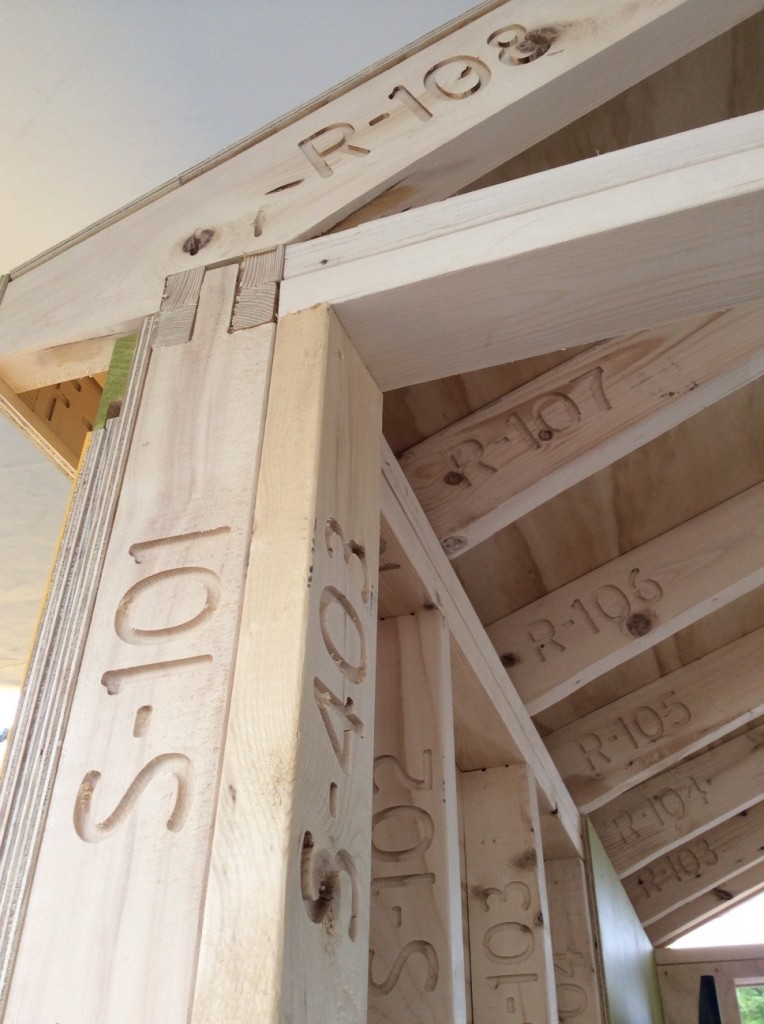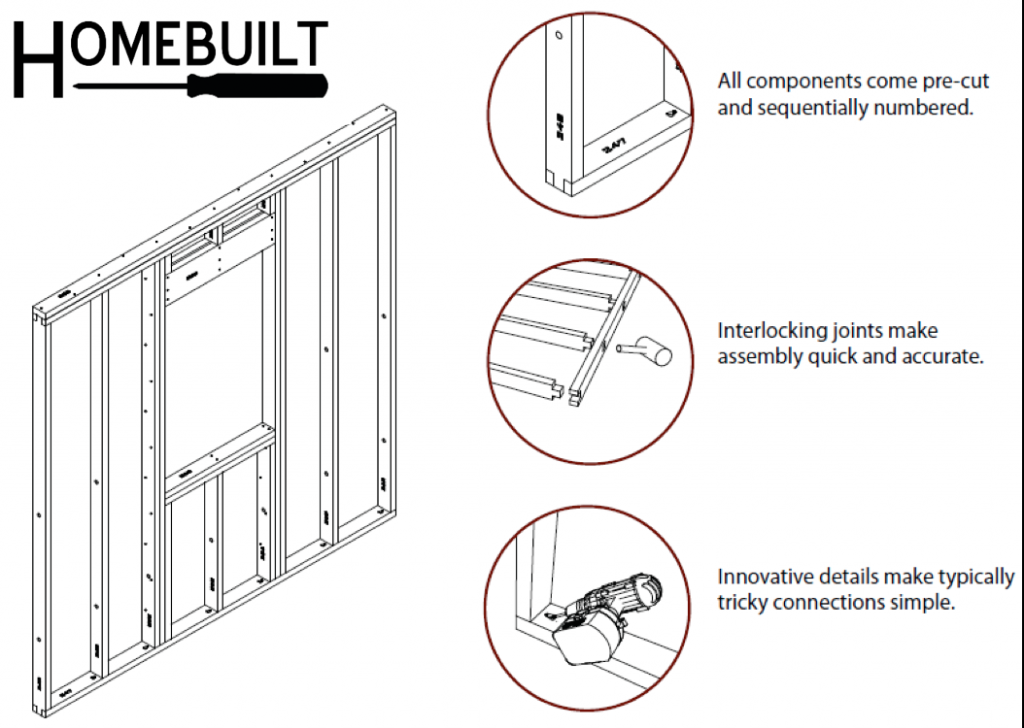Can’t get a mortgage? Get a kit and build your own code-compliant home.
by MichaelBerliner • June 16, 2014 • collaboration, Design, distributed manufacturing, home construction, shopbot, The Digital Fab Revolution
Not since the 1950’s has there been a readily available, sturdy, home building kit for use by any novice. With Homebuilt, architect Dennis Michaud is writing a new chapter in American home building. He recently contributed a post to ShopBot Tool’s blog entitled, “Homebuilt is Re-Inventing Homebuilding with Distributed Manufacturing (and ShopBots).” In the post, Michaud described recent projects that have served to inspire him — such as the Wikihouse, Shelter 2.0, and the Digitally Fabricated House for New Orleans at MoMA. He also shared his vision for Homebuilt: “to empower absolutely anyone, regardless of prior experience, with the knowledge and materials to modify an existing residential building or build a new home – themselves.”
We thought that 100kGarages users and enthusiasts would be interested in learning more about this fascinating business model, which looks to localized distributed manufacturing using digital fabrication to make it work. I spoke to Dennis by phone and have included some of our conversation here:
MB: First let me ask you to “paint a picture.” What is a Homebuilt home?
DM: Well basically it’s a kit to build a small home, with all of the lumber pre-cut with precision on a ShopBot CNC tool. The design is such that the structure will be all set to receive plumbing and electrical. Each piece is numbered, and delivered ready to put together at your home site. Any individual who can lift 23 lbs. can build this by herself or himself — though it’ll be more fun to do as a community! The parts have been engineered to prevent you from putting pieces together incorrectly.

Homebuilt structure was recently on display as a partial build at the 2014 Maker Faire San Mateo. Photo courtesy of Travis Good.
MB: Before starting up Homebuilt you were with Blu Homes?
DM: That’s right. I was one of the founders of the company and part of its leadership. We really grew quite quickly, especially in California. This concept enables people to buy a home that was built entirely in a factory, and shipped finished to their site. They are quite beautiful, eco-friendly and energy efficient.
MB: So what was your impetus for creating Homebuilt?
DM: Well I think it comes down to wanting to enable more people to have access to a quality home. Blu Homes is on the high end of the spectrum. I felt drawn to enabling people without a lot of capital, without access to a purchase mortgage, to use the incredible power afforded by digital fabrication technology to build for themselves and for their communities. The financial crisis of 2008 was traumatic to millions of Americans, and the ripples of that continue to this day. I know that a concept like Homebuilt can be a real solution for people who want to own a home.
MB: Expand on that a bit..
DM: Well, I know families that were impacted by this crisis — they lost their homes to bank foreclosure and have really struggled with the aftershocks of this, not just financially, but emotionally and psychologically. This is a microcosm for a larger problem in our country. Think about it: if you can’t get or don’t want a mortgage – and that’s a large and growing number of people today – then what are your choices? Renting is one option, if you live in an urban area, but there aren’t a lot of good rental options outside of the major cities. If you can pull together $50,000 say, which would be a great down payment on a $300,000 mortgaged home, you could use those funds to buy a manufactured home. But –- there is a lot of stigma written into the code around these homes. By definition, they are not permanent, so you can’t get a mortgage for one. Because they are not up to prescriptive codes they begin to depreciate immediately. So they are not really a great investment of that $50,000.
So my mission here is to enable anyone to build or buy a code-compliant, quality home that will last. And I want to emphasize the “enabling” piece of this.
MB: What do you mean?
DM: Well it’s that I don’t view myself a homebuilder, but rather a developer of technology that allows local businesses to create local products. Home buying and construction are very local by nature. People like to buy a home from a local builder. It’s best to use materials that are local. And of course there are local variations in building code that are important to be aware of. My goal with Homebuilt is to enable local businesses to serve their own communities with this most essential of things – the roof over your head. And by the way, the ability to lower materials shipping costs to the bare minimum will be a huge factor in making this concept work and grow.
MB: Can you give me an example of one of your introductory buildings?
DM: Sure. Our goal is to build modest sized spaces that take advantage of every square inch. This includes full-sized homes that are a perfect fit for some families, and can easily be expanded upon by others. Soon, we’ll be selling these kits online – starting very small so that we can continually make modifications based on many real-world scenarios — creating a continuous feedback loop between Homebuilt and a large variety of end users. So for instance, to begin we’ll be making kits for a “tiny house” or extra “mini-apartment” let’s say for a family member, as well as for things such as backyard offices and storage spaces.
MB: I understand you’re talking with Habitat for Humanity about getting Homebuilt involved with their mission.
DM: Yes. In so many ways they are a perfect fit. We can really help them become even more successful at fulfilling their mission; once again technology enables it. The current staffing model for a Habitat home-build requires a decent amount of professional oversight on all aspects of the build. And actually they are all volunteers. The construction expert is giving their time on a weekend to help out. With Homebuilt kits, everyone is empowered to build, without requiring expertise. So the volunteers are primed for success, and then the experts aren’t spread so thin. This can allow Habitat to serve more people in more communities.
Habitat for Humanity is actually doing a very “old” and beautiful thing. Two hundred years ago, if you wanted a home, the community would come together and help you build it. I’m looking to help people make this happen again using digital technologies.
100kGaragers, what do you think of the Homebuilt concept? How can this work in tandem with 100kGarages businesses? One challenge to the network is around the issue of quality-control. What thoughts does this inspire for you? We look forward to dialogue about it. You can learn more about Homebuilt at their website.

